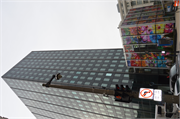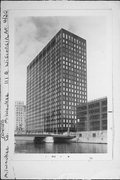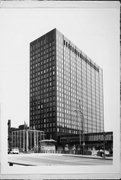Property Record
111 E WISCONSIN AVE
Architecture and History Inventory
| Historic Name: | Marine Plaza |
|---|---|
| Other Name: | Bank One Headquarters |
| Contributing: | |
| Reference Number: | 41150 |
| Location (Address): | 111 E WISCONSIN AVE |
|---|---|
| County: | Milwaukee |
| City: | Milwaukee |
| Township/Village: | |
| Unincorporated Community: | |
| Town: | |
| Range: | |
| Direction: | |
| Section: | |
| Quarter Section: | |
| Quarter/Quarter Section: |
| Year Built: | 1962 |
|---|---|
| Additions: | |
| Survey Date: | 198420162020 |
| Historic Use: | bank/financial institution |
| Architectural Style: | Late-Modern |
| Structural System: | |
| Wall Material: | Glass |
| Architect: | HARRISON AND ABRAMOVITZ; Turner Construction Co.-builders; United States Steel Corp.-contractors; F.H. Sparks Co.-glaziers |
| Other Buildings On Site: | |
| Demolished?: | No |
| Demolished Date: |
| National/State Register Listing Name: | Not listed |
|---|---|
| National Register Listing Date: | |
| State Register Listing Date: |
| Additional Information: | MILWAUKEE'S FIRST GLASS CURTAIN WALL BUILDING. A 'site file' exists for this property. It contains additional information such as correspondence, newspaper clippings, or historical information. It is a public record and may be viewed in person at the State Historical Society, Division of Historic Preservation. The former Marine Plaza is a twenty-two-story rectangular block and a freestanding two-story lobby pavilion. It is Milwaukee's best example of early curtain-wall construction, popular in large cities in the 1950s as building codes changed with advances in building technology. The development of steel-frame construction in the 1890s led to its application in the 1950s for curtain-wall buildings with an internal steel cage that bears a building’s entire weight. The walls hang on the cage, freed of their weight-bearing function. Steel-frame technology thus paved the way for tall buildings to be sheathed in glass, aluminum, and steel curtain walls. Early forms of curtain-wall construction emerged well before World War II, but the technique became especially prevalent in America after 1945, when large cities began sprouting tall, glass-and-steel apartment and office blocks. Marine Plaza was Milwaukee's first example. The prismatic building is isolated, breaking the city’s building line by the Milwaukee River providing strolling space and a pool for public meeting space. It was among the first buildings built to fit Milwaukee’s redevelopment scheme for the Milwaukee River, thus its abundant public space. An upturned slab on low piers, Marine Plaza hints its internal structure with stainless steel mullions trimming green-tinted glass sheathing. The Marine Bank Company was one of Milwaukee's pioneer banks. It merged with the Bank One Corporation in the 1980s, resulting in this building's current name. Turner Construction Company was the builder. |
|---|---|
| Bibliographic References: | ZIMMERMAN, 14. MILWAUKEE HISTORIC BUILDINGS TOUR: JUNEAUTOWN, CITY OF MILWAUKEE DEPARTMENT OF CITY DEVELOPMENT, 1994. Researched for Landmarks Commission. Buildings of Wisconsin manuscript. 2016- "The Marine Plaza building was constructed in 1961 and is believed to have been the first glass curtain wall building in Milwaukee. The Marine Plaza building is within the APE for proposed station site #7- Water/Wisconsin." -"Mult. Locations, Milwaukee, 7.5 series", WisDOT #2190-06-01, Prepared by Kelly Noack and Justin Miller, UWM-CRM (2016). Resurveyed 2016 by UWM-CRM as part of Milwaukee Bublr bikeshare project. Pagel, Mary Ellen & Virginia Palmer for the University of Wisconsin Extension Division, Guides to Historic Milwaukee: Juneautown Walking Tour, 1965. |
| Wisconsin Architecture and History Inventory, State Historic Preservation Office, Wisconsin Historical Society, Madison, Wisconsin |





